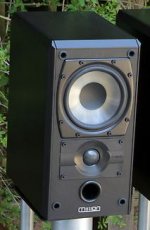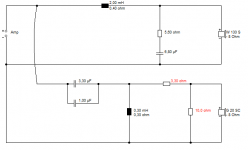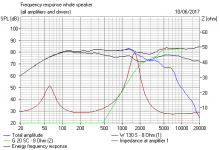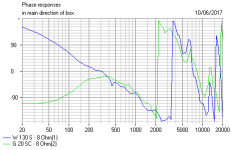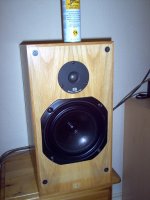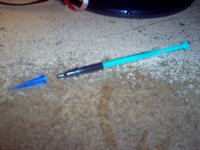..also, would I be right in thinking that changing this cap combination to a 6.8uF cap, as suggested on the first page, would have the effect of rolling off the treble a bit? ..or is that over-simplifying how it works?
Last edited:
The most probable answer why they used a combo of poly/electrolyte capacitor is the simplest one. Either they had a stock of these and/or it was cheaper that way without making too much of a compromise. Increasing to 6.8 uF would elevate lower trebble, lowering XO point, increasing the SPL summed in XO region, which may or may not be a good thing, who knows.
From what I've read, the Mission 751 has a rather irritating metal tweeter with a polycone 5" 6 ohm bass.
The ferrofluid is prone to solidifying, but easily replaced:
https://www.bluearan.co.uk/index.php?category=Speaker_Components&masthead=High_Frequency_Drivers&subheadnew=Ferrofluid
I suspect a 7.5R/0.68uF Zobel across the tweeter might help tame the top end.
Rough and guessy circuit below, disregard the level adjusting resistors. It all looks OK to me.
The ferrofluid is prone to solidifying, but easily replaced:
https://www.bluearan.co.uk/index.php?category=Speaker_Components&masthead=High_Frequency_Drivers&subheadnew=Ferrofluid
I suspect a 7.5R/0.68uF Zobel across the tweeter might help tame the top end.
Rough and guessy circuit below, disregard the level adjusting resistors. It all looks OK to me.
Attachments
Thanks for the info Steve. Regarding the 'irritating' metal tweeter, I think people have made unfair comment on that in the past - my perception is that it may sound a bit harsh on bright systems. It doesn't appear to have issues on most british or french made sources/amps ...from my experience (some amps tested with: A&R A60, Musical Fidelity A1, Atoll IN200).
I have replaced the capacitors with Dolan but noticed that one speaker is now more prominent than the other, louder on one of the tweeters.
Now, I have to use the amplifier balance setting to negate this.
Any advice to fix this?
Now, I have to use the amplifier balance setting to negate this.
Any advice to fix this?
It should be Solen caps, sorry for the auto correction.I have replaced the capacitors with Dolan but noticed that one speaker is now more prominent than the other, louder on one of the tweeters.
Now, I have to use the amplifier balance setting to negate this.
Any advice to fix this?
Hi Ed. You've probably worked out that I'm no expert but my logic says if you have checked the components and solder connections then maybe there is an issue with one of the tweeters/drivers. Did you replace all 4 caps or just the 3.3 and 1uf for the tweeter?
Unfortunately I have already checked for dry solder joints. No luck.Hi Ed. You've probably worked out that I'm no expert but my logic says if you have checked the components and solder connections then maybe there is an issue with one of the tweeters/drivers. Did you replace all 4 caps or just the 3.3 and 1uf for the tweeter?
Sent from my SM-G935F using Tapatalk
I would guess that 5uF would be fine for the tweeter but not sure that is right for the main driver ....but would need someone with more experience to comment on that. I used 6.8uF for the tweeter as it was suggested in the first page but I believe there is a tad too much lower treble coming through (only just though), so waiting for my 4.3uF's to arrive.
Thanks for sharing. I guess my problem is it's imbalanced now despite having the same cap values in both speakers. Need to figure how to troubleshoot if the tweeter has gone bad. I know the easiest way is to swap the xo boards and I will know the answer straightaway.I would guess that 5uF would be fine for the tweeter but not sure that is right for the main driver ....but would need someone with more experience to comment on that. I used 6.8uF for the tweeter as it was suggested in the first page but I believe there is a tad too much lower treble coming through (only just though), so waiting for my 4.3uF's to arrive.
That sounds like a good plan to narrow it down. Was there an issue before you changed the caps? ..if not, then that is bad luck.
I don't think the issue was there before the mod. But hey, it could just been that the original caps might have been just right. ;-)That sounds like a good plan to narrow it down. Was there an issue before you changed the caps? ..if not, then that is bad luck.
I'd suspect the ferrofluid has gone solid. Reduces level dramatically.
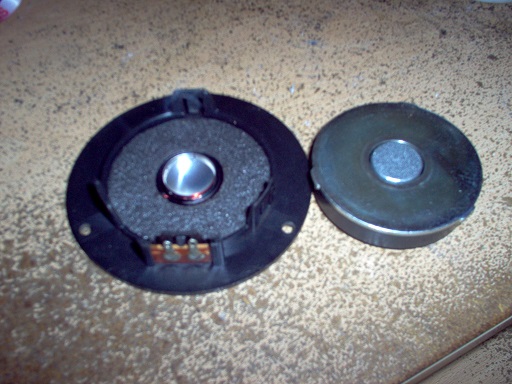
Easy enough to replace it:
Sonitus Audio Ferro Fluid (ferrofluid) for Speakers and Compression Drivers 0.5ml from Sonitus Audio 5.00
This is enough for 5 tweeters.
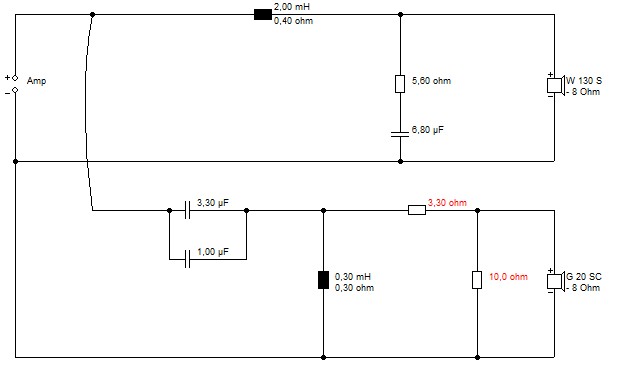
You want to do some modelling to guess what modifications might do. Maybe a third order tweeter filter with say a 6.8uF added would lift the 3kHz area, which is mostly what you hear.

Easy enough to replace it:
Sonitus Audio Ferro Fluid (ferrofluid) for Speakers and Compression Drivers 0.5ml from Sonitus Audio 5.00
This is enough for 5 tweeters.

You want to do some modelling to guess what modifications might do. Maybe a third order tweeter filter with say a 6.8uF added would lift the 3kHz area, which is mostly what you hear.
I'd suspect the ferrofluid has gone solid. Reduces level dramatically.

Easy enough to replace it:
Sonitus Audio Ferro Fluid (ferrofluid) for Speakers and Compression Drivers 0.5ml from Sonitus Audio 5.00
This is enough for 5 tweeters.

You want to do some modelling to guess what modifications might do. Maybe a third order tweeter filter with say a 6.8uF added would lift the 3kHz area, which is mostly what you hear.
Hey Steve,
This is fantastic suggestions. I will try with the Sonitus Audio Ferro Fluid. Let me try to order it.
Do you have a "How to fix a tweeter for dummies?" guide somewhere?
Hey Steve,
This is fantastic suggestions. I will try with the Sonitus Audio Ferro Fluid. Let me try to order it.
Do you have a "How to fix a tweeter for dummies?" guide somewhere?
I think I was being a bit lazy not to Google first: found this one which looks very illustrative - Replace ferrofluid in tweeter - a B&W tweeter as an example.
Hi I'm new to diyaudio, but have owned a pair of mission 751 from new. Although they seem to be working fine, I'm a bit concerned about the 'ferrofluid drying out issue', which they may be prone to, due to their age. Which is why this thread is of particular interest to me.
Could you fill me in on whether the fluid replacement was successful, and if so;
how you know how much to put in?
any complications to watch out for?
Any input would be much appreciated.
Could you fill me in on whether the fluid replacement was successful, and if so;
how you know how much to put in?
any complications to watch out for?
Any input would be much appreciated.
Let me explain it to you. Back in the day about 30 years ago, tweeters could only survive about 10 watts at parties. They tended to blow up.Hi I'm new to diyaudio, but have owned a pair of mission 751 from new. Although they seem to be working fine, I'm a bit concerned about the 'ferrofluid drying out issue', which they may be prone to, due to their age. Which is why this thread is of particular interest to me.
Could you fill me in on whether the fluid replacement was successful, and if so;
how you know how much to put in?
any complications to watch out for?
Any input would be much appreciated.

Then somebody discovered a magic mix of aviation fuel Kerosene, magnetic ferric oxide particles and a binding agent which got them working together. This increased momentary power to about a 100W. Because it just wicks away the heat to the magnetic gap.
Nothing is perfect. Hit them hard at parties and the oil tends to evaporate. Leaving solid sludge of magnetic dust. We need to replace the evaporated Kerosene oil.
Parts Express in the US sell you a minescule 0.1mL of new magnetic oil. For $5. Happily, Blue Aran in the UK can do much better, enough for about 5 tweeters: Sonitus Audio Ferro Fluid (ferrofluid) for Speakers and Compression Drivers 0.5ml PS3.60
TBH, the Mission 751 isn't the greatest speaker in the World. But nothing stopping you cleaning out the old solidified gunge and putting some new stuff in there. It's like oiling your bicycle chain. It just works better. Get it wrong by about 50%, it still works.
Attachments
Last edited:
- Home
- Loudspeakers
- Multi-Way
- Mission 751 Crossover Circuit Diagram
